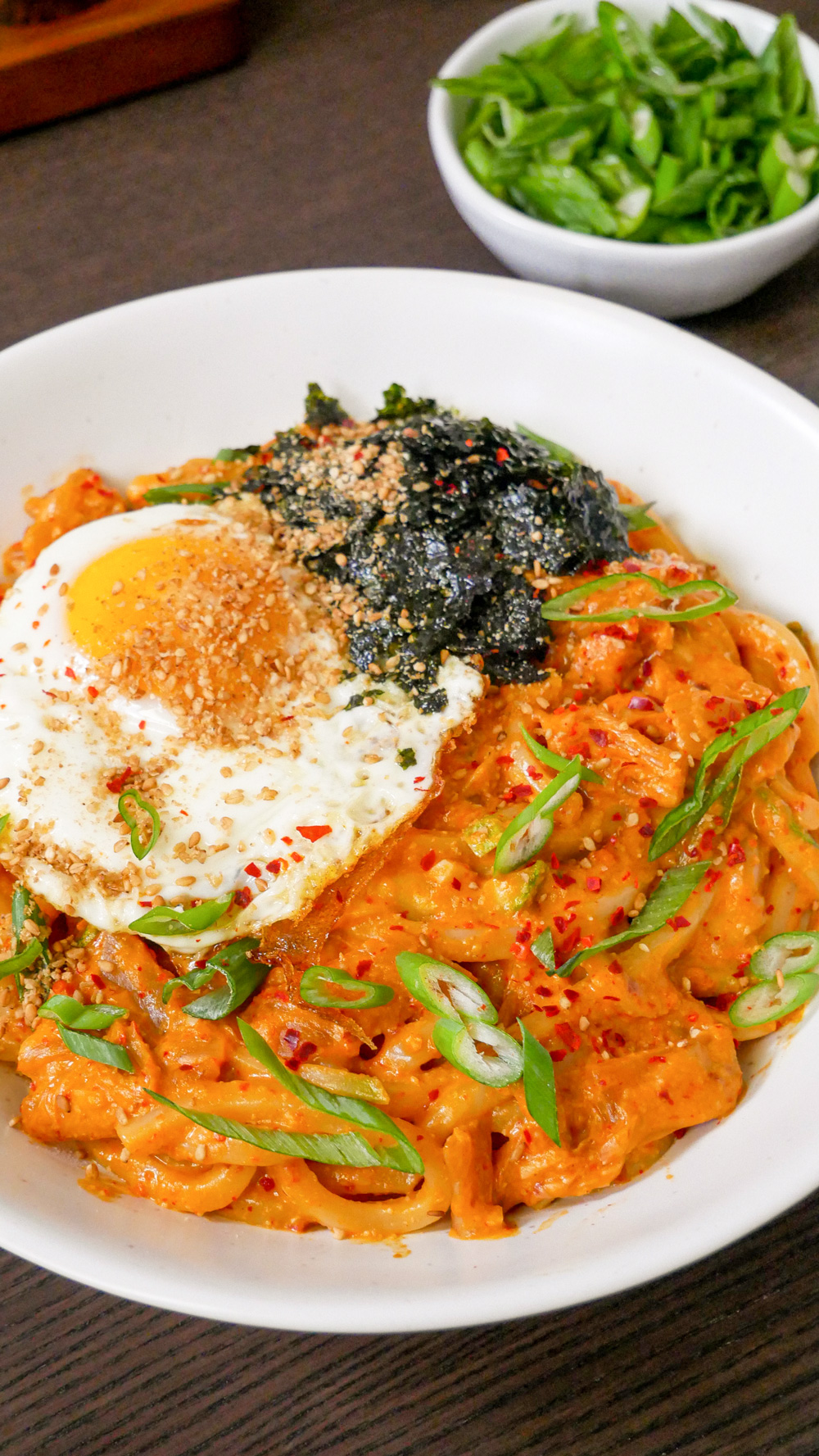Comfort for me usually comes in the form of noodles and this spicy, tangy, and savory creamy kimchi udon recipe feels like a warm hug in every bite! You’ve got chewy udon noodles coated in a flavorful creamy kimchi sauce and tossed with chopped kimchi and zucchini. To finish it off, I topped mine with fried eggs, chopped scallions, sesame seeds, and crushed seaweed but the possibilities are endless!
This kimchi udon is a complete meal that you can enjoy on its own and I’d say it’s a pretty balanced meal from the protein from the egg, carbs from the udon, and fiber from the kimchi and zucchini. But if you’re looking for side dishes to serve it with, here’s what I recommend:
- Korean Cabbage Pancake
- Cucumber Garlic
- Korean Radish Salad
- Cucumber Kimchi
- Pea Shoots with Garlic
- Fish Cake Soup
- Geotjeori Kimchi
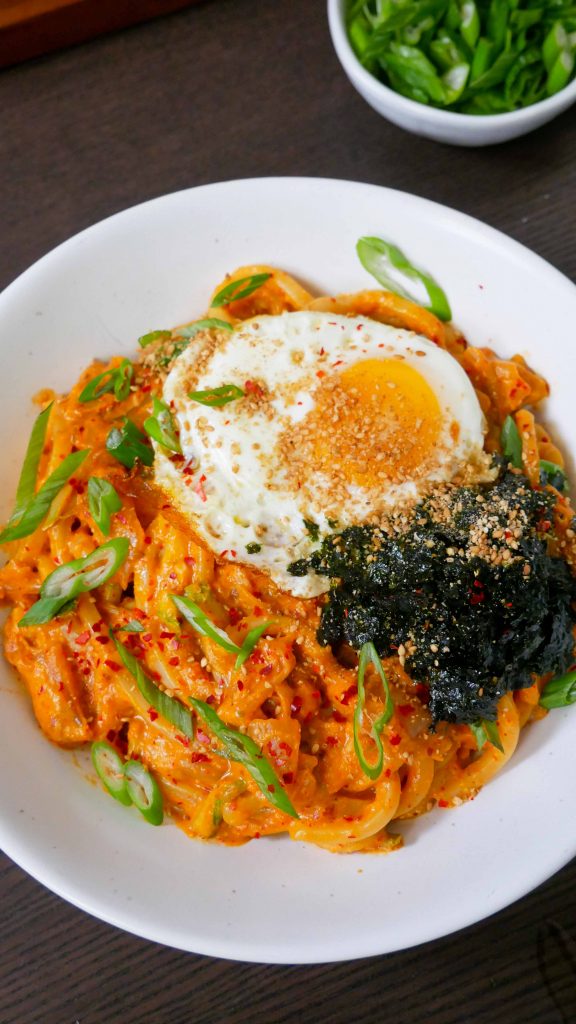
Why you’ll love this recipe
If you enjoy the flavors of kimchi fried rice, I guarantee you’ll love this recipe! It’s made of similar components with the addition of a creamy element. The ingredients you’ll need are simple and widely available in your local Asian mart. Best of all, this recipe comes together in just 20 minutes, making it perfect for busy nights or when you want a quick yet nourishing meal.
I opted to make my own cashew cream using soaked raw cashews and water to make this dish creamy while keeping it light. Cashew cream is my favorite heavy cream alternative because it adds the right amount of creaminess and luscious taste. Unlike coconut cream, which has an intense coconut flavor, cashew cream is fairly neutral in taste which allows for flavors to be built upon. You can also prepare and use cashew cream or substitute it with heavy cream or your cream of choice!
Now you can add any vegetables or proteins that you like. I kept this simple with kimchi and zucchini but you can add onions, spinach, bell peppers, and corn for veggies or chicken, bacon, pork belly, or even diced tofu for proteins. The same goes for the toppings! I topped mine with familiar ingredients that you’d typically find over kimchi fried rice but feel free to use whatever you desire. I love that this recipe is easily customizable based on what you have available and enjoy eating!
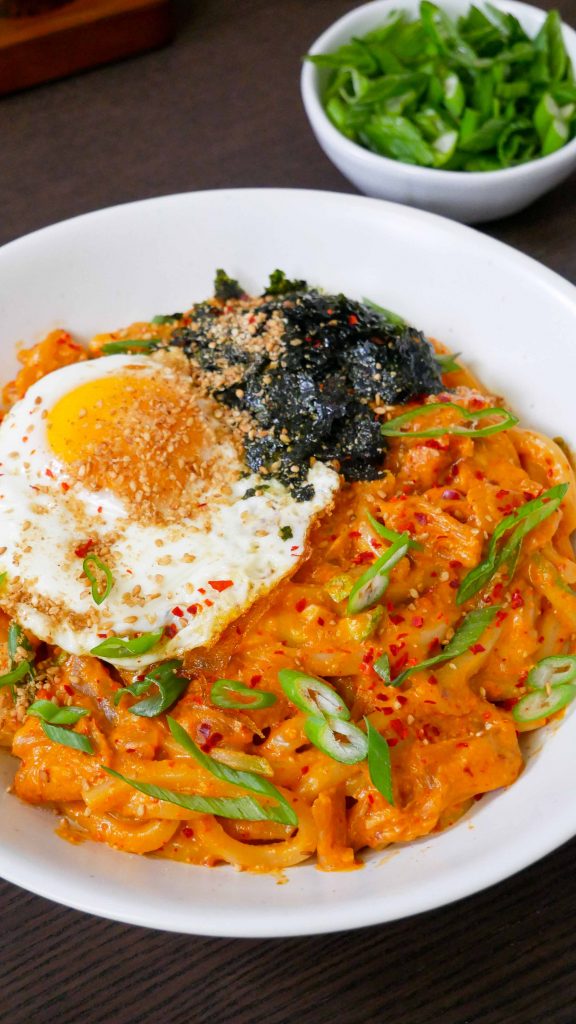
Creamy Kimchi Udon Ingredients & Substitutions
Udon noodles: You can use dried, fresh, or frozen udon but I highly recommend using frozen udon noodles if you can! They are chewier and bouncier than fresh udon. My favorite brand is Shirakiku Sanukiya Udon, which is usually found in the frozen section of your local Asian market.

Butter: Adds creaminess and richness to the dish. For the best quality and taste, I like to use butter with high-fat content!
Kimchi: Ideally, you want to use well-fermented or sour kimchi because they have a deeper flavor and more complex taste. If you only have fresh kimchi, that’s okay – just add a splash of vinegar and mix it with the kimchi!
Kimchi juice: Added for a deeper kimchi flavor.
Zucchini: I love zucchini with kimchi dishes! When selecting fresh zucchini, look for ones that are smooth and have bright green-colored skin. They should feel heavy and firm when given a bit of pressure. You can substitute this with squash or any vegetable you like!
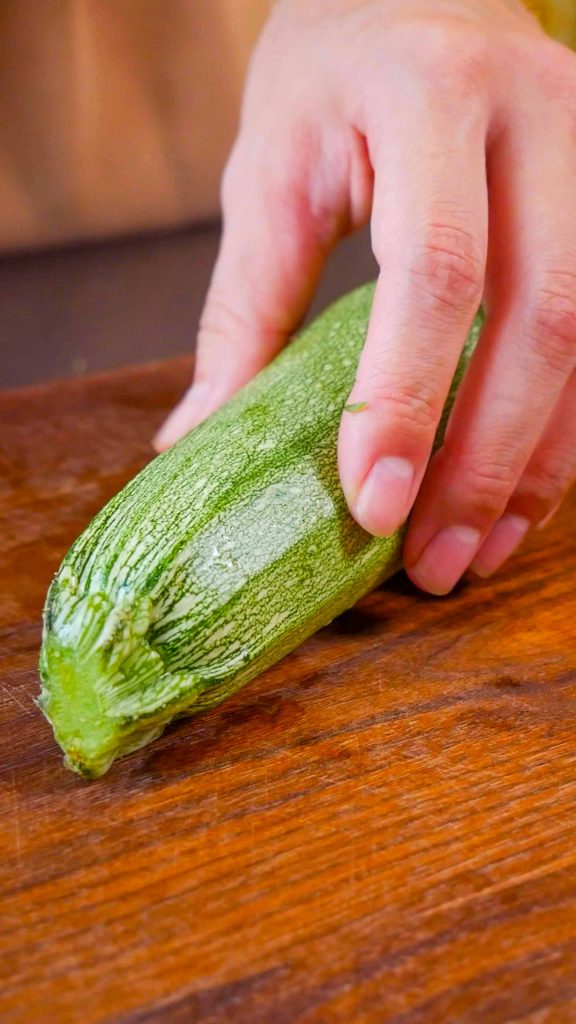
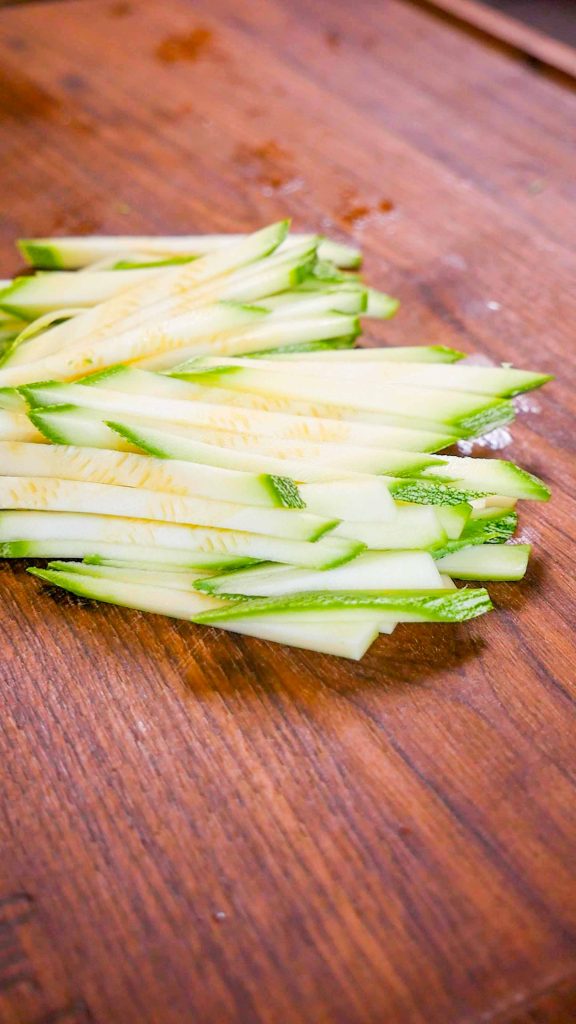
Garlic cloves: For a delicious garlicky aroma and flavor. Feel free to add more!
Coarse gochugaru: or Korean red chili powder, is used for spice. This can be substituted with red chili flakes or togarashi.
Soy sauce: For added umami and seasoning. I like using
Cashew cream: I used homemade cashew cream (recipe below) to keep my udon light. This can be substituted with heavy cream.
Udon water: To help give the sauce body and loosen it up if needed.
Homemade Cashew Cream
Raw cashews: You must use raw unsalted cashews to make the cream. Roasted salted cashews will not work for this. Fresh raw cashews have a pleasant nutty aroma, no off or foul smell, and the least breakage on each individual nut.
Water: To help cream the cashews
Toppings
Eggs: I always like to have a fried egg whenever I make this kimchi udon. I keep the yolk runny and break it into the noodles, making the sauce even creamier! For other protein options to substitute this with, you can use chicken, bacon, pork belly, beef, or even tofu as a plant-based option.
Scallion: Added for freshness and color
Sesame seeds: For added texture and nuttiness.
Crushed seaweed: This adds saltiness and umami that compliments the taste of kimchi. Optional but highly recommended!
How to Prepare Creamy Kimchi Udon
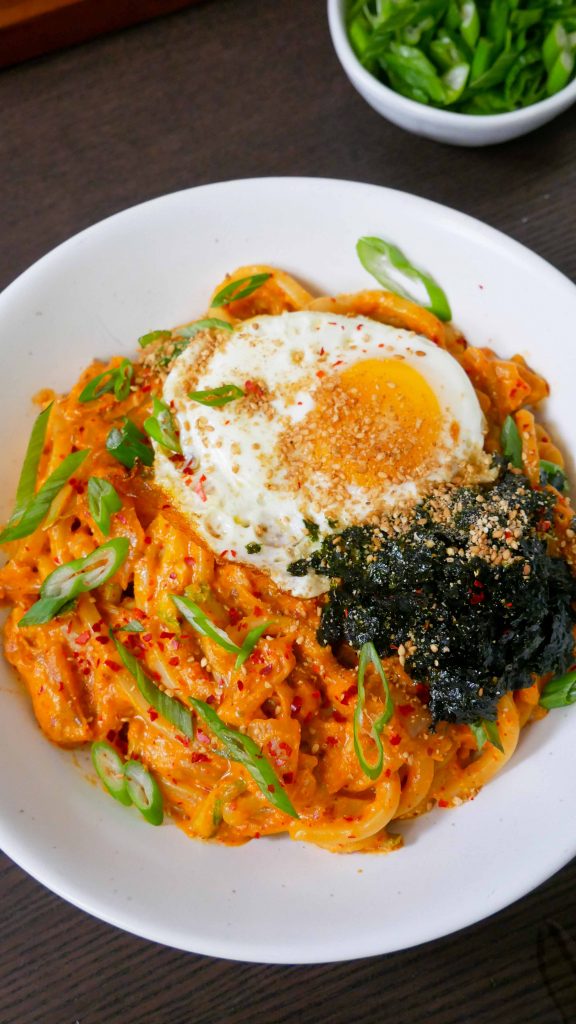
Step 1: Prepare the cream
If using heavy cream or pre-made dairy-free cream, skip this step. To prepare the cashew cream, place the raw cashews in a heat-proof bowl. Pour hot boiling water over the cashews until they’re completely submerged. Set aside for 10 minutes. Strain then transfer the cashews with 1/2 cup of water into a high-speed blender. Blend until smooth. Transfer to a sterilized glass jar or container and set aside in the fridge until ready to use.
Step 2: Soak the udon noodles
To prepare the udon noodles, transfer them to a heat-proof bowl. Pour hot boiling water over the udon until completely submerged. Set the timer for 1 minute. Reserve 2 to 3 tablespoons of udon water then strain. If possible, do this while you prepare the sauce to prevent the udon noodles from getting soggy.
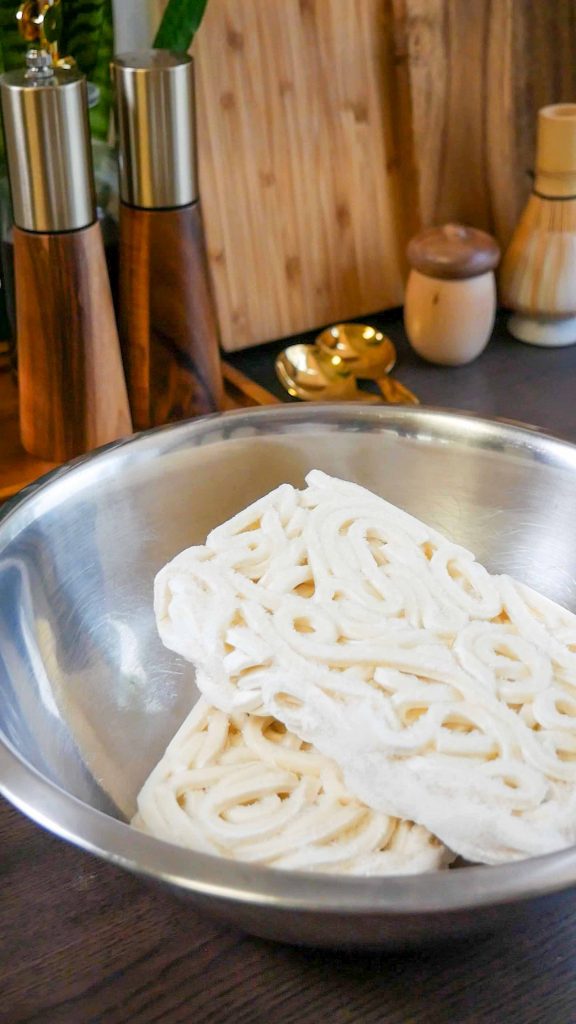
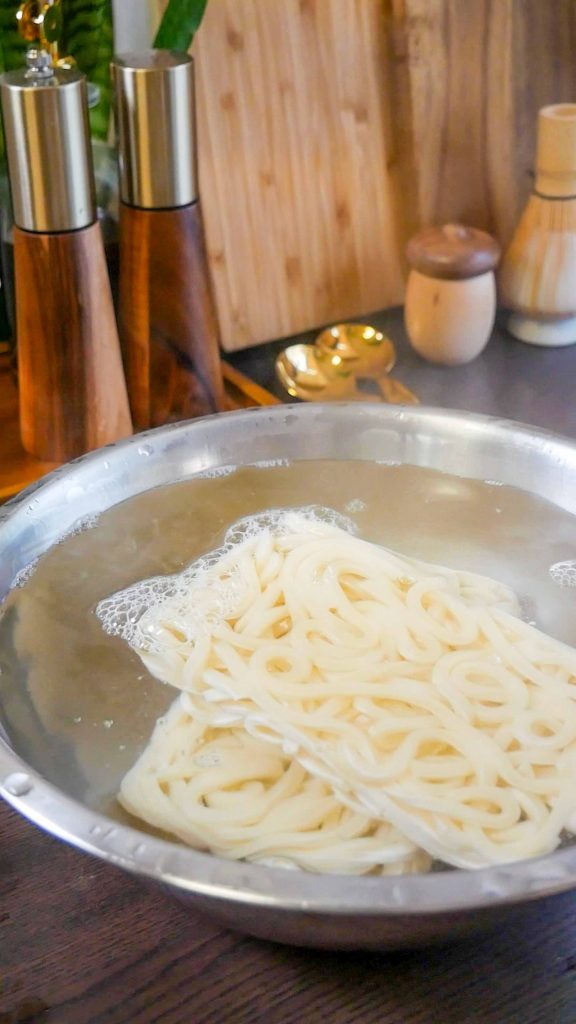
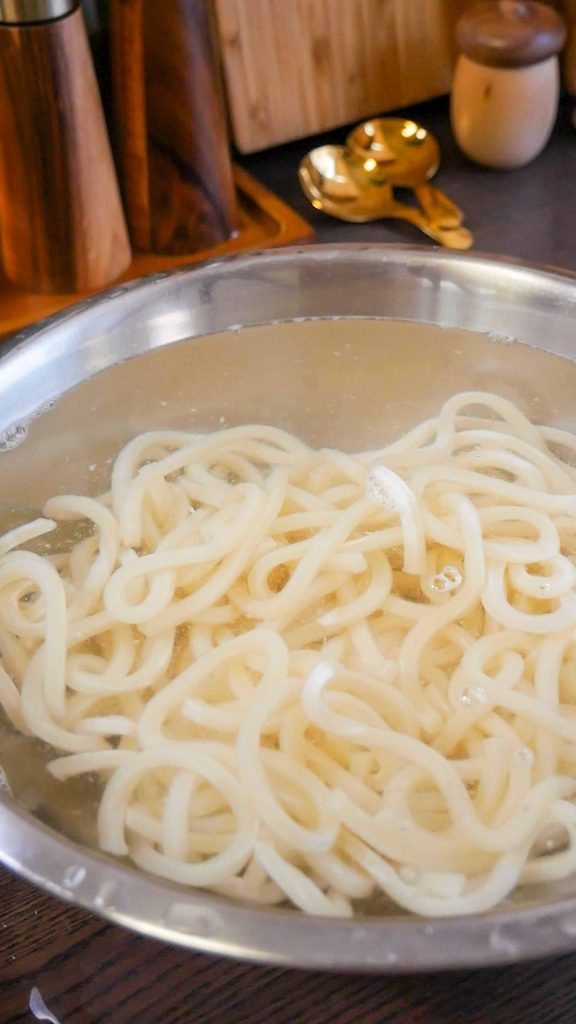
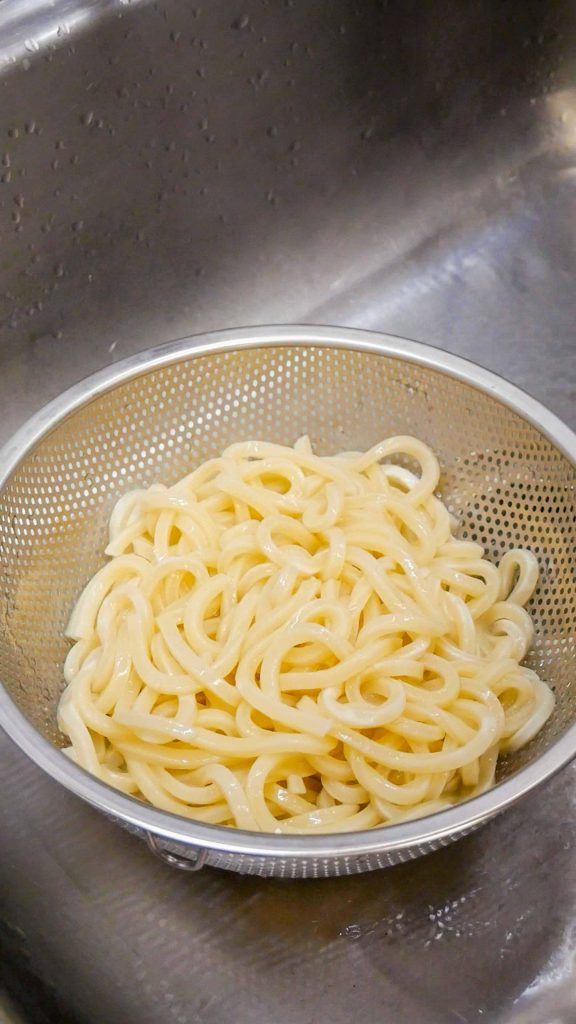
Step 3: Saute the kimchi
Heat butter in a pan over medium heat. Toss in the chopped kimchi. Cook for 2 to 3 minutes until softened, making sure to constantly stir.
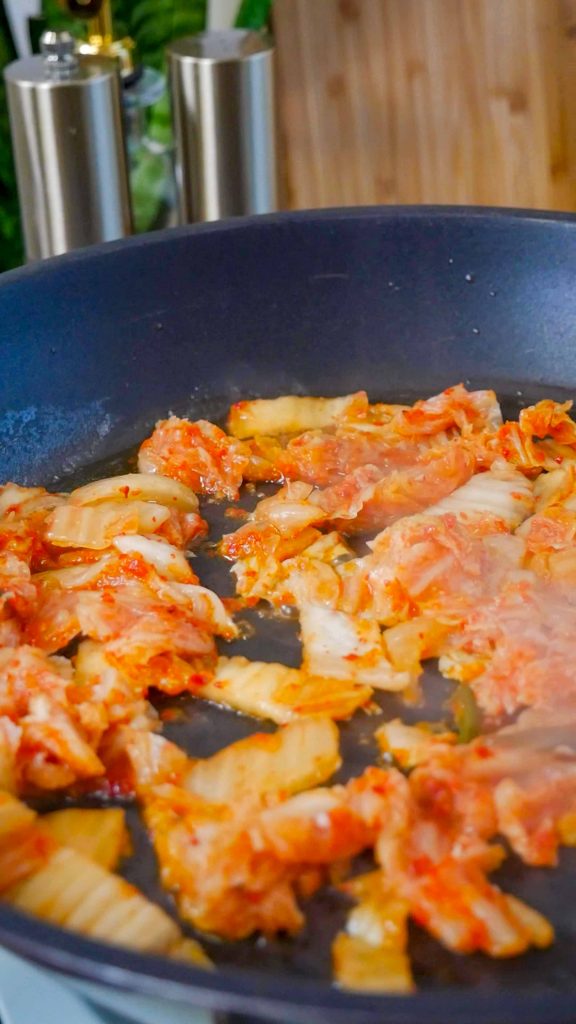
Step 4: Saute the veggies
Add the minced garlic and sliced zucchini. Cook for about 2 minutes or until the zucchini are tender.
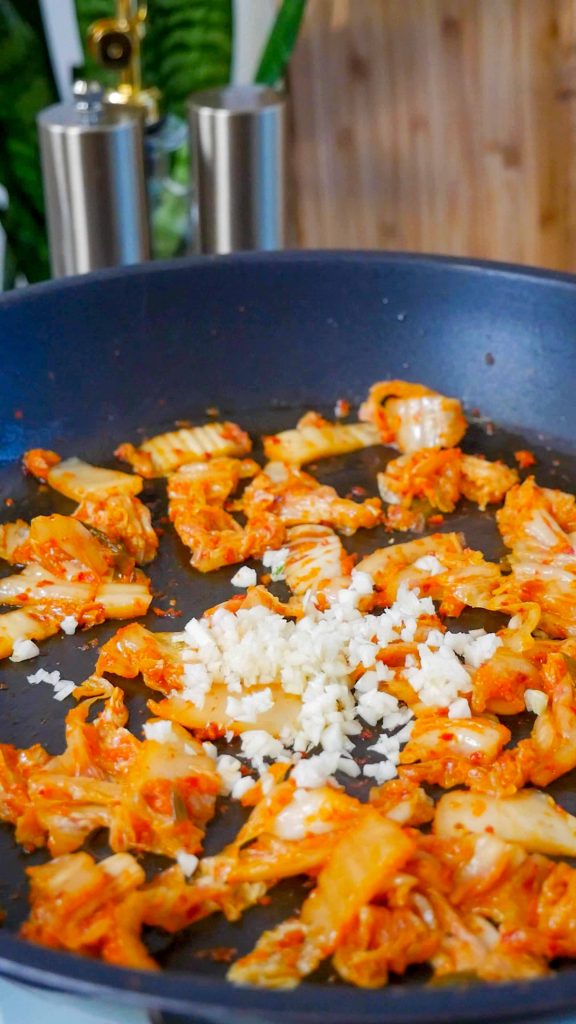

Step 5: Make the sauce
Add gochugaru, kimchi juice, soy sauce and mix well. Pour in the cream and mix until well combined.
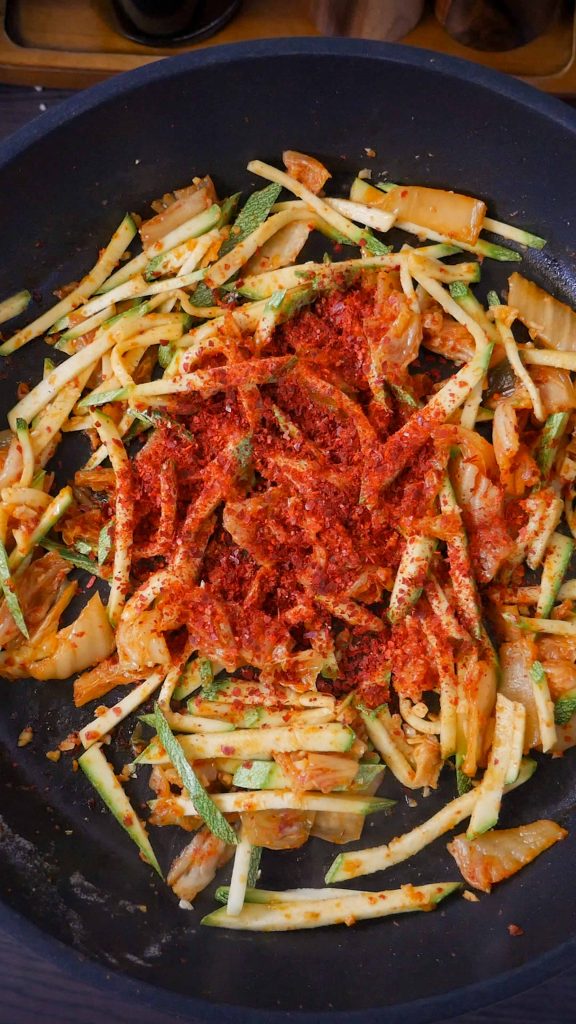
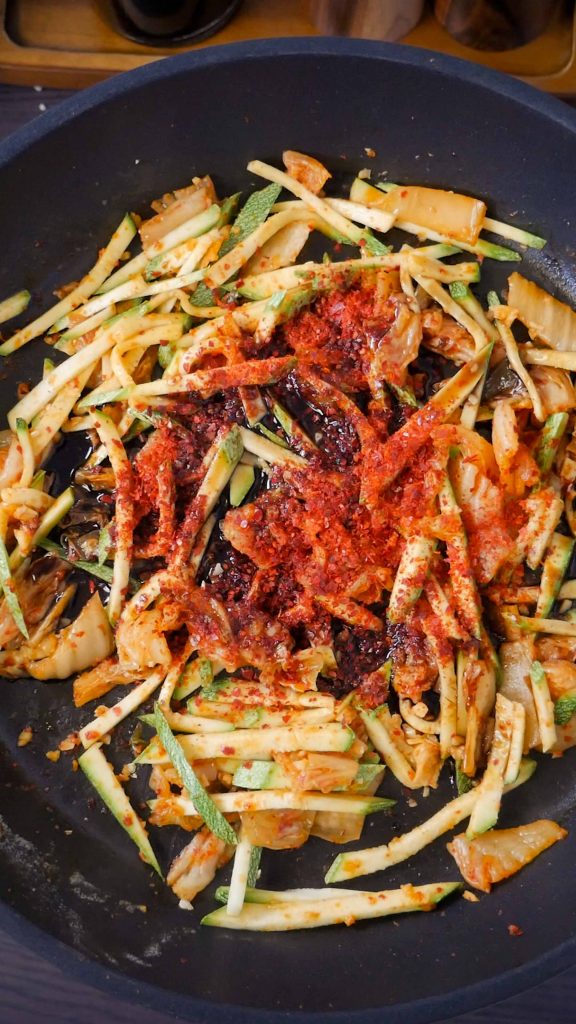


Step 6: Add the udon noodles
Toss in the udon noodles and mix to coat well. If the sauce is too thick, add udon water as needed.
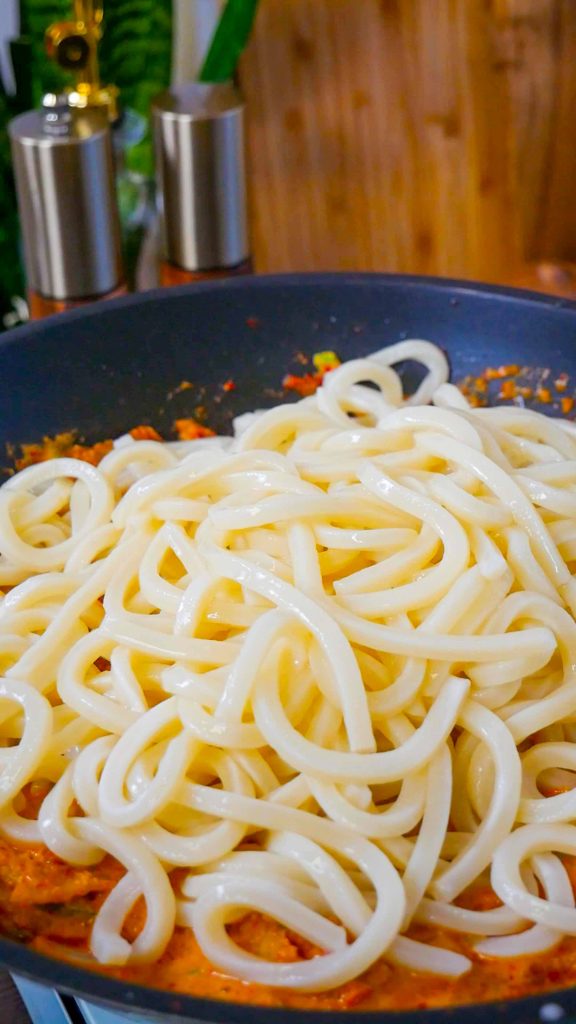
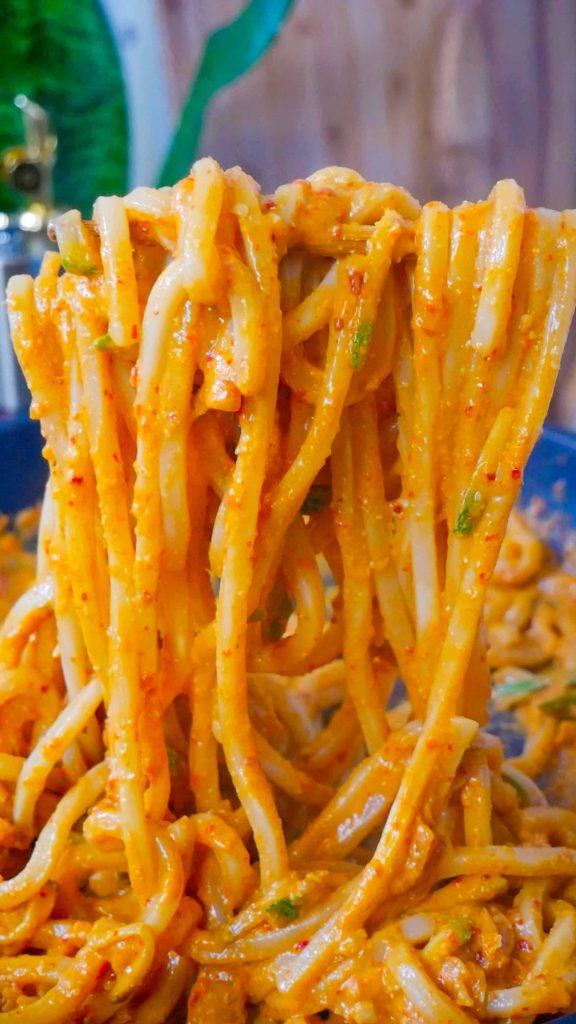
Step 7: Plate and serve
Transfer to a serving plate. Top with a fried egg, scallion, and sesame seeds.

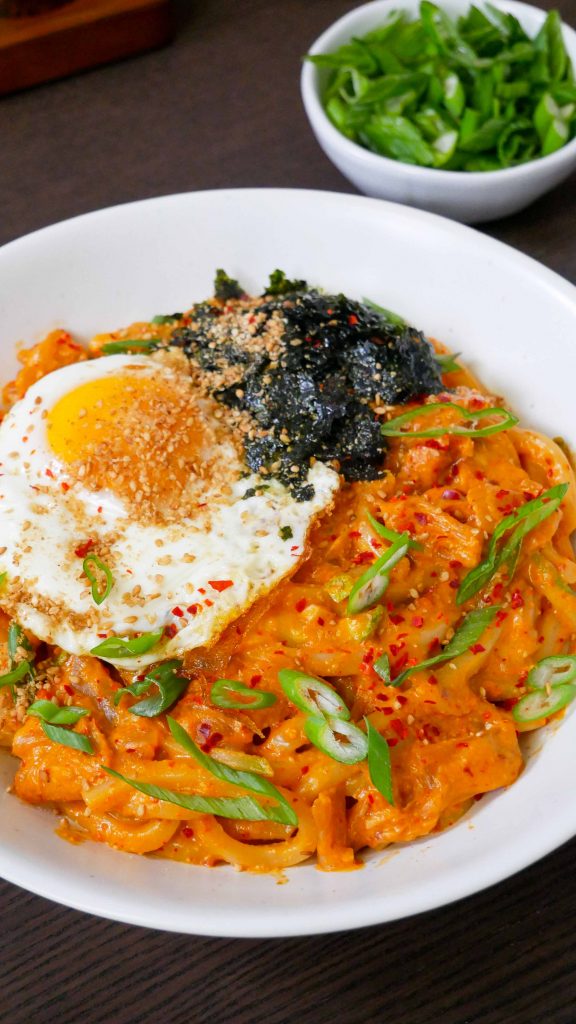
Preparation Tips for Creamy Kimchi Udon
Here are some helpful tips for making the most delicious creamy kimchi udon every time:
- Pick the right udon! I recommend using frozen udon because they are chewier and bouncier than fresh udon and dried udon but feel free to use what you have available! Fresh udon will be just as delicious.
- Control the spice level by adjusting the amount of kimchi and gochugaru. As an alternative, you can serve gochugaru on the side so that you or your guests have a better grip on the spiciness of their udon.
- Add other vegetables of your choice. For instance, you can add carrots, corn, edamame, peas, cabbage, bell peppers, and other vegetables. Be creative! If using larger vegetables like cabbage and bell peppers, I recommend slicing them thinly so that they’re easier to mix into the udon.
- Use a heavy-bottomed non-stick pan or wok. This conducts heat very well, making it great for stir-frying.
Frequently Asked Questions
Do you soak udon noodles before cooking?
Yes. If you’re using dried udon noodles, cook them according to the package instructions. Gresh or frozen udon noodles only need to be soaked in hot water for 1 minute. Be sure not to over soak them otherwise, this will cause them to turn mushy.
Is udon Korean or Japanese?
Udon is a traditional Japanese noodle known for its delightful chewy texture! It’s made with only three main ingredients: flour, water, and salt, and is extremely versatile as it can be served hot or cold. These ingredients are combined and then kneaded multiple times to develop the gluten which gives it its distinct chewy texture. This recipe is a Japanese and Korean fusion dish using udon and kimchi, and while this is not traditional by any means, it’s absolutely delicious!
How to cook frozen udon for kimchi udon?
Frozen udon does not need to be thawed or defrosted prior to cooking. You can take it straight out of the freezer and soak it in hot water for 1 minute. After draining well, add the noodles directly into the pan or sauce. Do note that the longer the udon sits in any liquid or on heat, the mushier it gets, so timing is key!
How to get the right chewy texture for kimchi udon?
The quality of the noodles will depend on the brand that you will use. Frozen udon noodles usually have the best chewy texture, so I recommend using it if you can find it! Another point to consider is the proper cooking and timing. Udon can go from chewy to mushy when overcooked, so be sure to keep an eye on it – a minute is all you need if using frozen or fresh udon.
Can kimchi udon be made in advance?
For best results, you’d want to enjoy this dish hot and fresh! As the udon noodle sits, it loses its chewiness and turns soggy so ideally, you’d want to eat it right from the stove. If you do plan on making it ahead of time, you can refrigerate it in an air-tight container and reheat it. Just make sure to add a splash of water to the udon to help loosen it up before reheating it in the microwave or over the stovetop.
Looking for more easy and delicious noodle recipes?
Spicy Seafood Yaki Udon Noodles — Seafood yaki udon is a Japanese seafood udon stir fry that’s easy, delicious and comes together in just 30 minutes! It’s made with assorted seafood like shrimp, squid, and scallops that are tossed with chewy udon noodles and a simple savory sauce.
Miso Udon Noodle Soup — If you’re like me and you can’t resist a delicious bowl of noodles, wait until you try this miso udon noodle soup. You’re probably already familiar with udon noodle soup and miso soup, but this delicious fusion combines the best of both worlds.
Curry Udon Noodles with Egg — If you’re looking for a no-frills, easy weeknight meal, this curry udon with egg is the one for you! There’s something so incredibly comforting about a bowl of udon noodles that are smothered in a rich and velvety curry. And best of all – it only takes 20 minutes to prepare!
Mentaiko Udon — If you’re not familiar with mentaiko, it is a Japanese seafood that’s made from fermented cod or pollock roe (eggs). Mentaiko is also called ‘myeongran-jeot’ in Korean, which is where it originated from. it’s full of umami and packed with flavor, and when added to the sauce for this udon recipe, results in a delicious and indulgent meal. Make it in just 10 minutes!
Korean Spicy Cold Noodles — Also known as ‘bibim myeon‘ (비빔면) or ‘bibim guksu‘ (비빔국수), these cold noodles are a summer favorite in my home. It’s a spicy, sweet, and tangy cold noodle dish that’s perfect for when you’re craving a refreshing and nourishing meal. It’s also incredibly easy to make, ideal for days when you don’t want to spend too much time cooking. 10 minutes is all you need to make this refreshing meal.
Ginger Scallion Noodles — These noodles are a regular in my dinner rotation. Super quick and easy, packed with flavor and only takes 20 minutes to make! The dried knife-cut noodles soak up all the flavor from the infused oil. Then I add whatever leftover protein I have like chicken to make it heartier!

Creamy Kimchi Udon Recipe
Ingredients
- 2 packs of udon frozen or fresh
- 1 tbsp unsalted butter
- 3/4 cup kimchi chopped
- 2 tbsp kimchi juice
- 1/2 cup zucchini sliced into matchsticks
- 3 garlic cloves minced
- 2 tsp coarse gochugaru substitute with red chili flakes
- 2 tbsp soy sauce
- 1/2 cup cashew cream substitute with heavy cream
- 2-3 tbsp udon water as needed
Homemade Cashew Cream
- 1/2 cup raw cashews
- 1/2 cup water
Toppings
- 2 eggs
- 1 scallion chopped
- sesame seeds
- crushed seaweed
Instructions
Homemade Cashew Cream
- If using heavy cream or pre-made dairy-free cream, skip this step. To prepare the cashew cream, place the raw cashews in a heat-proof bowl. Cover with hot boiling water until completely submerged. Set aside for 10 minutes. Strain then transfer the cashews with 1/2 cup of water into a high-speed blender. Blend until smooth.
Udon Noodles
- To prepare the udon noodles, transfer them to a heat proof bowl. Pour hot boiling water over the udon until completely submerged. Set the timer for 1 minute. Reserve 2 to 3 tablespoons of udon water then strain. If possible, do this while you prepare the sauce to prevent the udon noodles from getting soggy.
Creamy Kimchi Udon
- Heat butter in a pan over medium heat. Toss in the chopped kimchi. Cook for 2 to 3 minutes until softened, making sure to constantly stir.
- Add the minced garlic and sliced zucchini. Cook for about 2 minutes or until the zucchini are tender.
- Add gochugaru, kimchi juice, soy sauce and mix well. Pour in the cream and mix until well combined.
- Toss in the udon noodles and mix to coat well. If too thick, as udon water as needed.
- Transfer to a serving plate. Top with a fried egg, scallion, and sesame seeds.
